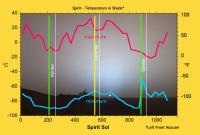Printable Version of Topic
Click here to view this topic in its original format
Unmanned Spaceflight.com _ Tech, General and Imagery _ Temperature Measurements?
Posted by: antoniseb Mar 8 2012, 07:38 PM
Do Spirit and Oppy report air temperatures on a regular basis?
I've assumed they do, but I don't recall ever seeing any kind of report showing the day-to-day changes.
Over on BAUTForum, someone is asking about the temperature, and it would be nice to have a non-guess answer about the difference between the temp at aphelion and perihelion.
Thanks in advance.
Posted by: Astro0 Mar 8 2012, 10:16 PM
The Rovers don't carry instruments to determine air temperature as such.
The best you can generally say is that it ranges from 'cold to really, really cold'. ![]()
On board instruments can provide an inferred temperature range.
One of the goals of the Rover mission is to characterise the daily weather conditions through observations.
http://marsrover.nasa.gov/science/goal2-results.html
The Mars Reconnaissance Orbiter's MARCI Instrument is designed to further observe weather conditions on the planet.
http://www.msss.com/msss_images/latest_weather.html
In general, across the Mars year, it is estimated that temperatures vary from a high of 20°C (68°F) to a low of -140°C (-220°F). Average temperature is -63 °C (-81 °F).
Google is your friend!
Posted by: centsworth_II Mar 8 2012, 10:34 PM
http://marsrover.nasa.gov/spotlight/20070612.html has a lot of information.
"Rover engineer Dan Porter has been tracking temperatures recorded by 50 or so sensors on each of the rovers since shortly after they landed on Mars in January 2004. The results are not only of interest to scientists, they're a favorite of human audiences as well."
"During their exploration of Mars, the rovers have recorded temperatures ranging from midday highs of about 35 degrees C. (95 degrees F.) in spring and summer to nighttime lows of about minus 110 degrees C. (minus 166 degrees F.) in winter."
Posted by: antoniseb Mar 9 2012, 12:27 AM
"Rover engineer Dan Porter has been tracking temperatures recorded by 50 or so sensors on each of the rovers since shortly after they landed on Mars in January 2004. The results are not only of interest to scientists, they're a favorite of human audiences as well."
"During their exploration of Mars, the rovers have recorded temperatures ranging from midday highs of about 35 degrees C. (95 degrees F.) in spring and summer to nighttime lows of about minus 110 degrees C. (minus 166 degrees F.) in winter."
Thanks! It doesn't quite tell me the aphelion/perihelion variations, but its a start.
Posted by: djellison Mar 9 2012, 01:08 AM
Viking did this very well
http://www-k12.atmos.washington.edu/k12/resources/mars_data-information/data.html
Posted by: rlorenz Mar 9 2012, 03:28 AM
[color="#000080"]
"Rover engineer Dan Porter has been tracking temperatures recorded by 50 or so sensors on each of the rovers since shortly after they landed on Mars in January 2004. The results are not only of interest to scientists, they're a favorite of human audiences as well."
If they're of such interest (and I totally agree), are they going to be put on the PDS ?
Posted by: centsworth_II Mar 9 2012, 05:33 AM
I don't know if it's any help, but based on aphelion dates of Aug 8, 2004 and June 26, 2006 and a perihelion date of July 17, 2005, I place these events thusly on the graph from http://marsrover.nasa.gov/spotlight/20070612.html. Aphelions are in green and perihelion in yellow. I did my own calculations so buyer beware!
Posted by: djellison Mar 9 2012, 07:36 AM
I found the EPOXI camera temp plots that went on the PDS fascinating. They only cover 2007-11, but they're interesting none the less.
I know that the headers for every image in the PDS have a swathe of temperature readings within them.
-8.08166 <degC>,-7.32423 <degC>,
-7.36011 <degC>,-7.57261 <degC>,
-13.3241 <degC>,-13.5143 <degC>,
-9.27266 <degC>)
INSTRUMENT_TEMPERATURE_NAME = ("FRONT HAZ ELECTRONICS",
"REAR HAZ ELECTRONICS",
"LEFT PAN ELECTRONICS","LEFT PAN CCD",
"RIGHT PAN CCD","LEFT NAV CCD","MI CCD"
,"MI ELECTRONICS","DESCENT CAMERA CCD")
I agree though - a verbose temp sensor dump would be fascinating for MER (and Phoenix)
Posted by: Drkskywxlt Mar 9 2012, 01:08 PM
Might already know this, but MSL will have meteorological sensors and take regular temperature measurements. It's measurement cadence will be 1 Hz for 5 minutes every hour every sol. That adds up to 2 hours per sol. There is also power budgeted for another hour per sol for scheduled observation, so that could be a 1 hour continuous block or be split between the various 5 minute periods to lengthen them based on what's going on weather-wise.
Posted by: mwolff Mar 9 2012, 05:30 PM
The best you can generally say is that it ranges from 'cold to really, really cold'.
On board instruments can provide an inferred temperature range.
Google is your friend!
This is not quite true. Using Mini-TES observations of the surface, one can derive an "average" air temperature in the bottom 1.5 meter that is sampled along the path...by modeling the 15-micron CO2 with standard radiative transfer techniques (i.e., you need a combination of absorption and emission...but it is mainly an absorption effect by the colder air against the "warmer" surface for the day; the reverse for night). This works for most of the day and at night when there is enough surface-atmosphere thermal contrast. The science team has done this for the period when there was useful MiniTES data; I will dig this up and post a link to something that can be downloaded.
The science team always talked about correlating this with the onboard sensors -- which suffer from being inside the rover in some and thus not isolated from such thermal effects (even the one in the APXS probably has some contamination in it) -- in order to derive a calibration. However, I don't think that any one actually did this (on the science side).
Powered by Invision Power Board (http://www.invisionboard.com)
© Invision Power Services (http://www.invisionpower.com)

